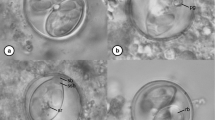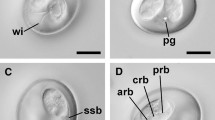Abstract
To date, more than 50 Eimeria spp. have been isolated from marsupials of the family Macropodidae. Although 18 species of Eimeria have been previously detected from multiple animal species belonging to the genus Macropus of the family, limited genetic analyses of the parasites are available, and their pathogenicity remains unclear. Here, we report the isolation of Eimeria spp. from a zoo specimen of red-necked wallaby (Macropodidae; Macropus rufogriseus). Specifically, two distinct types of Eimeria oocysts were recovered, one from the feces before treatment with an anthelmintic and the second from the intestinal contents after death of the animal. The oocysts obtained from the two sources were morphologically identified as E. hestermani and E. prionotemni, respectively. We successfully determined partial gene sequences from the two isolates, including segments of the 18S rRNA genes, and for the first time have used phylogenetic analyses of these sequences to assign the species to distinct clades. In combination with further genetic data, these results are expected to help elucidate the pathogenicity and host ranges of Eimeria spp. within the respective family and genus.




Similar content being viewed by others
References
Abe N, Tanoue T, Ohta G, Iseki M (2008) First record of Eimeria furonis infection in a ferret, Japan, with notes on the usefulness of partial small subunit ribosomal RNA gene sequencing analysis for discriminating among Eimeria species. Parasitol Res 103:967–970
Austen JM, Friend JA, Yang R, Ryan UM (2014) Further characterisation of two Eimeria species (Eimeria quokka and Eimeria setonicis) in quokkas (Setonix brachyurus). Exp Parasitol 138:48–54
Barker IK, O'Callaghan MG, Beveridge I (1989) Host-parasite associations of Eimeria spp. (Apicomplexa: Eimeriidae) in kangaroos and wallabies of the genus Macropus (Marsupialia: Macropodidae). Int J Parasitol 19:241–263
Brown Jordan A, Blake D, Beard J, Beharry A, Serrette L, Soleyn A, Sookhoo J, Blake L, Brown G, Oura C (2018) Molecular identification of Eimeria species in broiler chickens in Trinidad, West Indies. Vet Sci 5:pii:E12
Chapman HD, Barta JR, Blake D, Gruber A, Jenkins M, Smith NC, Suo X, Tomley FM (2013) A selective review of advances in coccidiosis research. Adv Parasitol 83:93–171
Dai Y, Liu M, He N, Tao J, Liu X (2005a) The life cycle and pathogenicity of Eimeria fulva Farr, 1953 in domestic goslings. Acta Protozool 44:311–319
Dai Y, Liu X, Liu M, Tao J (2005b) The life cycle and pathogenicity of coccicium Eimeria nocens (Kotlán, 1933) in domestic goslings. J Parasitol 91:1122–1126
Das M, Deka DK, Sarmah PC, Islam S, Sarma S (2015) Diversity of Eimeria spp. in dairy cattle of Guwahati, Assam, India. Vet World 8:941–945
Daugschies A, Bangoura B, Lendner M (2013) Inactivation of exogenous endoparasite stages by chemical disinfectants: current state and perspectives. Parasitol Res 112:917–932
Hafeez MA, Shivaramaiah S, Dorsey KM, Ogedengbe ME, El-Sherry S, Whale J, Cobean J, Barta JR (2015) Simultaneous identification and DNA barcoding of six Eimeria species infecting turkeys using PCR primers targeting the mitochondrial cytochrome c oxidase subunit I (mtCOI) locus. Parasitol Res 114:1761–1768
Hasegawa M, Kishino H, Yano T (1985) Dating of the human-ape splitting by a molecular clock of mitochondrial DNA. J Mol Evol 22(2):160–174
Hill NJ, Richter C, Power ML (2012) Pinning down a polymorphic parasite: new genetic and morphological descriptions of Eimeria macropodis from the Tammar wallaby (Macropus eugenii). Parasitol Int 61:461–465
Hume ID, Jarman PJ, Renfree MB, Temple-Smith PD (1989) Macropodidae. In: Walton DW, Richardson BJ (Eds.), Fauna of Australia, AGPS Canberra, pp. 1–70
Jeanes C, Vaughan-Higgins R, Green RE, Sainsbury AW, Marshall RN, Blake DP (2013) Two new Eimeria species parasitic in corncrakes (Crex crex) (Gruiformes: Rallidae) in the United Kingdom. J Parasitol 99:634–638
Jenkins MC (2001) Advances and prospects for subunit vaccines against protozoa of veterinary importance. Vet Parasitol 101:291–310
Jinneman KC, Wetherington JH, Hill WE., Omiecinski CJ, Adams AM, Johnson JM. Tenge BJ, Dang NL, Wekell MM (1999) An oligonucleotide-ligation assay for the differentiaton between Cyclospora and Eimeria spp. polymerase chain reaction amplification products. J Food Prot 62:682-685
Larkin MA, Blackshields G, Brown NP, Chenna R, McGettigan PA, McWilliam H, Valentin F, Wallace IM, Wilm A, Lopez R, Thompson JD, Gibson TJ, Higgins DG (2007) Clustal W and Clustal X version 2.0. Bioinformatics 23:2947–2948
Lee SH, Lee K, Kim KT, Choi EJ, Kwak D (2019) Morphological and molecular diagnosis of Eimeria sp. that caused fatality in a red-necked wallaby (Macropus rufogriseus) in Korea. Parasitol Int 71:147–150
Matsubayashi M, Takami K, Abe N, Kimata I, Tani H, Sasai K, Baba E (2005) Molecular characterization of crane Coccidia, Eimeria gruis and E. reichenowi, found in feces of migratory cranes. Parasitol Res 97:80–83
Matsubayashi M, Matsuura Y, Nukata S, Daizi Y, Shibahara T, Teramoto I, Matsuo T, Uni S, Hatta T, Kaneko A, Tsuji N, Sasai K (2018) First detection and molecular identification of Entamoeba bovis from Japanese cattle. Parasitol Res 117:339–342
McDonald V, Shirley MW (2009) Past and future: vaccination against Eimeria. Parasitol 136:1477–1489
Murakoshi F, Koyama K, Akasaka T, Horiuchi N, Kato K (2018) Molecular and histopathological characterization of Cryptosporidium and Eimeria species in bats in Japan. J Vet Med Sci 80:1395–1399
Mykytowycz R (1964) Coccidia in wild populations of the red kangaroo, Megaleia Rufa (Desmarest), and the grey kangaroo, Macropus canguru (Müller). Parasitology 54:105–115
Ogedengbe JD, Hunter DB, Barta JR (2011) Molecular identification of Eimeria species infecting market-age meat chickens in commercial flocks in Ontario. Vet Parasitol 178:350-354
Power ML, Richter C, Emery S, Hufschmid J, Gillings MR (2009) Eimeria trichosuri: Phylogenetic position of a marsupial coccidium, based on 18S rDNA sequences. Exp Parasitol 122:165–168
Prasad H (1960) A new species of Coccidia of the red kangaroo Macropus rufus Mamm. Z Parasitenkd 20:385–389
Pyziel AM, Demiaszkiewicz AW (2015) Observations on sporulation of Eimeria bovis (Apicomplexa: Eimeriidae) from the European bison Bison bonasus: effect of temperature and potassium dichromate solution. Folia Parasitol 62
Schrenzel MD, Maalouf GA, Gaffney PM, Tokarz D, Keener LL, McClure D, Griffey S, McAloose D, Rideout BA (2005) Molecular characterization of isosporoid coccidia (Isospora and Atoxoplasma spp.) in passerine birds. J Parasitol 91:635–647
Tamura K, Nei M (1993) Estimation of the number of nucleotide substitutions in the control region of mitochondrial DNA in humans and chimpanzees. Mol Biol Evol 10:512–526
Tamura K, Stecher G, Peterson D, Filipski A, Kumar S (2013) MEGA6: molecular evolutionary genetics analysis version 6.0. Mol Biol Evol 30:2725–2729
Tenter AM, Barta JR, Beveridge I, Duszynski DW, Mehlhorn H, Morrison DA, Thompson RC, Conrad PA (2002) The conceptual basis for a new classification of the coccidia. Int J Parasitol 32:595–616
Twomey DF, Boon JD, Hume MJ, Schock A, Wood R (2008) Concurrent coccidiosis and listeriosis in a Bennett’s wallaby (Macropus rufogriseus). Vet Rec 163:635–636
Twomey DF, Vine NJ, Wessels ME, Wood R, Rosie WG (2010) Eimeria prionotemni-associated coccidiosis in a Bennett’s wallaby (Macropus rufogriseus). Vet Rec 167:621–622
Uga S, Matsuo J, Kono E, Kimura K, Inoue M, Rai SK, Ono K (2000) Prevalence of Cryptosporidium parvum infection and pattern of oocyst shedding in calves in Japan. Vet Parasitol 94:27–32
Wenyon CM, Scott HH (1925) Exhibitions of sections of the small intestine of a Bennett’s wallaby (Macropus bennetti) containing various parasites. Trans R Soc Trop Med Hyg 19:7–8
Yakimoff VL, Matschoulsky SN (1936) Coccidiosis in the kangaroo. J Parasitol 22:514–515
Yang R, Fenwick S, Potter A, Elliot A, Power M, Beveridge I, Ryan U (2012) Molecular characterization of Eimeria species in macropods. Exp Parasitol 132:216–221
Yang R, Brice B, Bennett MD, Ryan U (2013) Novel Eimeria sp. isolated from a King’s skink (Egernia kingii) in Western Australia. Exp Parasitol 133:162–165
Yang R, Brice B, Ryan U (2014) A new Caryospora coccidian species (Apicomplexa: Eimeriidae) from the laughing kookaburra (Dacelo novaeguineae). Exp Parasitol 145:68–73
Yang R, Brice B, Ryan U (2016) Morphological and molecular characterization of Eimeria purpureicephali n. sp. (Apicomplexa:Eimeriidae) in a red-capped parrot (Purpureicephalus spurius, Kuhl, 1820) in Western Australia. Int J Parasitol Parasites Wildl 5:34–39
Zwart P, Strik WJ (1964) Globidiosis in a Bennett’s wallaby. Tijdschr Diergeneeskd 89:138–143
Acknowledgments
The authors gratefully acknowledge Mr. M. Kobayashi, Ms. M. Shimada, Mr. Y. Abeto, and Mr. H. Itoh (National Institute of Animal Health, Japan) for histopathological assistance and Mrs. Rika Sekiguchi and Mrs. Noriko Asama for help in the fecal and molecular examinations.
Funding
This work was supported in part by Grants-in-Aid for Scientific Research from the Ministry of Education, Culture, Sports, Science and Technology (JSPS) (Grant nos. 16H05803 and 16 K08025 to M.M.).
Author information
Authors and Affiliations
Corresponding author
Ethics declarations
Conflict of interest
The authors declare that they have no conflicts of interest.
Additional information
Section Editor: Berit Bangoura
Publisher’s note
Springer Nature remains neutral with regard to jurisdictional claims in published maps and institutional affiliations.
Rights and permissions
About this article
Cite this article
Ekawasti, F., Kitagawa, K., Domae, H. et al. Molecular identification of Eimeria hestermani and Eimeria prionotemni from a red-necked wallaby (Macropodidae; Macropus rufogriseus) in Japan. Parasitol Res 119, 1271–1279 (2020). https://doi.org/10.1007/s00436-020-06618-2
Received:
Accepted:
Published:
Issue Date:
DOI: https://doi.org/10.1007/s00436-020-06618-2




